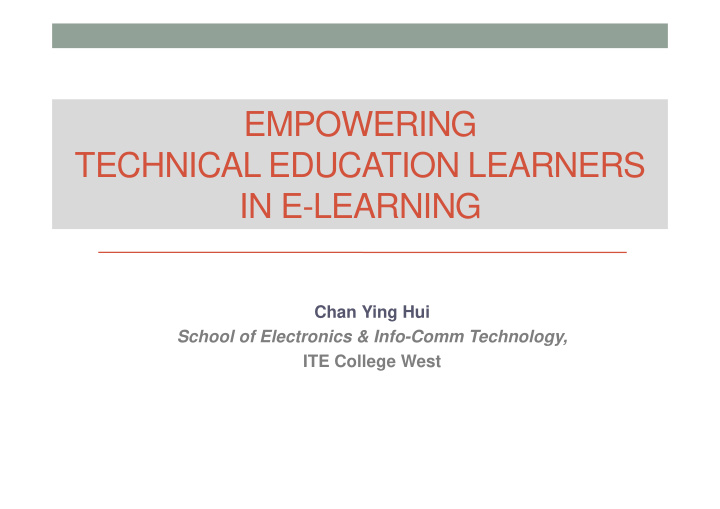



EMPOWERING TECHNICAL EDUCATION LEARNERS IN E-LEARNING Chan Ying Hui School of Electronics & Info-Comm Technology, ITE College West
Challenges Skills: Communication, 21st century Collaborative, learners Information Technology
Pedagogy “…using technology is the students’ job; the teachers’ job is to coach and guide the use of technology for effective learning..” “..digital technology is the enabler, allowing students to teach themselves in ways they couldn’t in the past..” Partnering Pedagogy (Marc Prensky, 2010)
VAK Learning Style
VAK Learning Style
Technical Education Visual learners Short attention span Kinesthetic in nature
Empowering ELearning “..The core elements of active learning are student activity and engagement in the learning process, and active learning is often contrasted to the traditional lecture where students passively receive information from the instructor..” (Michael Prince, 2004)
Video: Empowering ELearning
Empowering ELearning Teacher Active Peer Facilitation Learning Facilitation
Empowering ELearning “…Peer mediation with young children is a relatively novel approach aimed at teaching young children how to mediate to their peers; the main benefits of peer mediation are in developing children's mediation teaching style and cognitive modifiability…” (Tzuriel, 2007)
Differentiated Learning “.. Differentiated instruction is based upon the concept that the teacher is a facilitator of information, while students take the primary role of expanding their knowledge through research..” (Robinson et al., 2014) Group work Individual work
Differentiated Learning Design For in Technical Education By
Kolb’s Experiential Learning Cycle Concrete Experience Active Reflective Experimentation Observation Abstract Conceptualization
Adaptation of Kolb’s Experiential Learning Cycle
Kolb’s Experiential Learning Cycle Adaptation of Incidental Theory – 1st Cycle
Adaptation of Kolb’s Experiential Learning Cycle Empowering ELearning (Creator Perspective) – 2nd Cycle
Adaptation of Kolb’s Experiential Learning Cycle Empowering ELearning (User Perspective) – 3rd Cycle
Survey No. Survey Question 1 This method helps me understand the lesson better. 2 I find that I am able to pay more attention in class. 3 I am able to understand the concept better. I like to use the eLearning material developed by my classmate for 4 revision. Note: Likert Scale (Strongly Disagree: 1 point; Disagree: 2 points; Undecided: 3 points; Agree: 4 points; Strongly Agree: 5 points) Mean = 3.58 points
Survey “I like to use the eLearning material developed by my classmate for revision.” Highest mean (3.79 points)
Conclusion Positive peer influence Technology Teacher facilitation Goal: strengthen student’s learning experience. Encouraging a caring and supportive learning environment.
Thank you
Recommend
More recommend